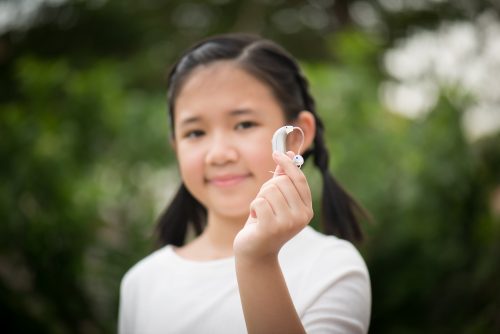Frequently Asked Questions: Hearing Aids
 Hearing aids can help improve hearing and speech, especially in children with sensorineural hearing loss. Sensorineural hearing loss is in the inner ear due to damaged hair cells or a damaged hearing nerve. Causes include noise, injury, infection, certain medications, birth defects, tumors and blood circulation problems.
Hearing aids can help improve hearing and speech, especially in children with sensorineural hearing loss. Sensorineural hearing loss is in the inner ear due to damaged hair cells or a damaged hearing nerve. Causes include noise, injury, infection, certain medications, birth defects, tumors and blood circulation problems.
Hearing aids (electronic or battery-operated) can amplify and change sound. A microphone receives the sound and converts it into sound waves. The sound waves then convert into electrical signals.
What are the different types of hearing aids?
The type of hearing aid recommended for your child will depend on several factors, including his or her physical limitations, medical condition and personal preference. There are many types of hearing aids on the market, with companies continuously inventing newer, improved hearing aids. However, there are four basic types of hearing aids available today. Consult your child’s doctor or audiologist for additional information on each of the following types:
In-the-ear (ITE) hearing aids
These hearing aids come in plastic cases that fit in the outer ear. Generally used for mild to severe hearing loss, ITE hearing aids can accommodate other technical hearing devices, such as the telecoil, a mechanism used to improve sound during telephone calls. However, their small size can make it difficult to make adjustments. In addition, ear wax and drainage can damage ITE hearing aids.
Behind-the-ear (BTE) hearing aids
As the name implies, children should wear BTE hearing aids behind the ear. This type of hearing aid, which is in a case, connects to a plastic earmold inside the outer ear. These hearing aids are for mild to severe hearing loss. However, poorly fitted BTE hearing aids can cause feedback, an annoying “whistling” sound, in the ear.
Canal aids
Canal aids fit directly in the ear canal and come in two styles: in-the-canal (ITC) aid and completely-in-canal (CIC) aid. Customized to fit the size and shape of the individual’s ear canal, canal aids are generally for mild to moderate hearing loss. However, because of their small size, removal and adjustment may be more difficult. In addition, ear wax and drainage can damage canal aids.
Body aids
Generally reserved for profound hearing loss, or if the other types of hearing aids will not accommodate, body aids are attached to a belt or pocket and connected to the ear with a wire.
Who may be a candidate for hearing aids?
Nearly all children who have a hearing loss can benefit from these devices. The type of hearing aid recommended may depend on several factors, including, but not limited to, the following:
- Shape of the outer ear (deformed ears may not accommodate behind-the-ear hearing aids)
- Depth of depression near the ear canal (too shallow ears may not accommodate in-the-ear hearing aids)
- Type and severity of hearing loss
- Manual dexterity of the child to remove and insert hearing aids
- Amount of wax build-up in the ear (excessive amounts of wax or moisture may prevent use of in-the-ear hearing aids)
- Ears that require drainage may not be able to use certain hearing aid models
How should I take care of my child’s hearing aids?
Hearing aids need to be dry. Methods for cleaning hearing aids vary depending on the style and shape. Other tips for taking care of hearing aids include:
- Keep the hearing aids away from heat.
- Replacing batteries on a regular basis.
- Avoid the use of hairspray and other hair products when the hearing aid is in place.











